PROJ6016 - Project Management Methodologies: Agile vs. Scrum Analysis
VerifiedAdded on 2022/11/23
|9
|2552
|276
Report
AI Summary
This report delves into project management methodologies, primarily focusing on Agile and Scrum. It begins by establishing the importance of selecting the right methodology for project success, referencing the Project Management Body of Knowledge (PMBOK) and its five key steps: initiation, planning, execution, monitoring and controlling, and closing. The report then differentiates between traditional project management and Agile methodologies, highlighting the flexibility and iterative nature of Agile, especially its suitability for software development. It explains the Agile process, including iterations, prototyping, and the roles of Scrum Master and Product Owner. The report further details the Scrum methodology, emphasizing its iterative and incremental approach, sprint cycles, and key artifacts such as product backlogs, sprint backlogs, and burn-down charts. It outlines the activities involved in Scrum, including sprint planning, daily scrums, and sprint reviews. The report also touches on the application of Agile project management, concluding that the flexibility of Agile and Scrum is a key factor for adoption, as it facilitates project adaptation and change management during the development process.
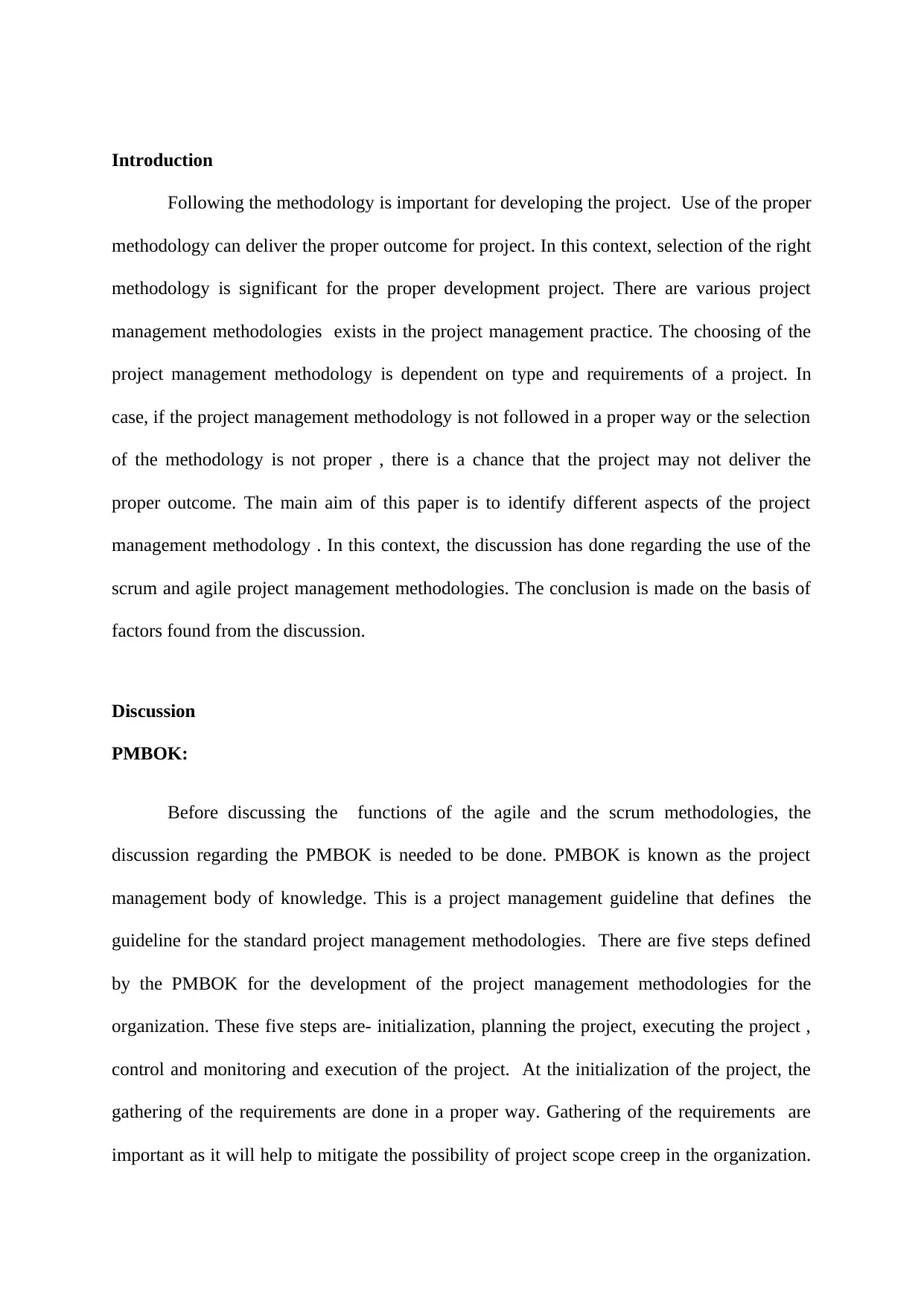
Introduction
Following the methodology is important for developing the project. Use of the proper
methodology can deliver the proper outcome for project. In this context, selection of the right
methodology is significant for the proper development project. There are various project
management methodologies exists in the project management practice. The choosing of the
project management methodology is dependent on type and requirements of a project. In
case, if the project management methodology is not followed in a proper way or the selection
of the methodology is not proper , there is a chance that the project may not deliver the
proper outcome. The main aim of this paper is to identify different aspects of the project
management methodology . In this context, the discussion has done regarding the use of the
scrum and agile project management methodologies. The conclusion is made on the basis of
factors found from the discussion.
Discussion
PMBOK:
Before discussing the functions of the agile and the scrum methodologies, the
discussion regarding the PMBOK is needed to be done. PMBOK is known as the project
management body of knowledge. This is a project management guideline that defines the
guideline for the standard project management methodologies. There are five steps defined
by the PMBOK for the development of the project management methodologies for the
organization. These five steps are- initialization, planning the project, executing the project ,
control and monitoring and execution of the project. At the initialization of the project, the
gathering of the requirements are done in a proper way. Gathering of the requirements are
important as it will help to mitigate the possibility of project scope creep in the organization.
Following the methodology is important for developing the project. Use of the proper
methodology can deliver the proper outcome for project. In this context, selection of the right
methodology is significant for the proper development project. There are various project
management methodologies exists in the project management practice. The choosing of the
project management methodology is dependent on type and requirements of a project. In
case, if the project management methodology is not followed in a proper way or the selection
of the methodology is not proper , there is a chance that the project may not deliver the
proper outcome. The main aim of this paper is to identify different aspects of the project
management methodology . In this context, the discussion has done regarding the use of the
scrum and agile project management methodologies. The conclusion is made on the basis of
factors found from the discussion.
Discussion
PMBOK:
Before discussing the functions of the agile and the scrum methodologies, the
discussion regarding the PMBOK is needed to be done. PMBOK is known as the project
management body of knowledge. This is a project management guideline that defines the
guideline for the standard project management methodologies. There are five steps defined
by the PMBOK for the development of the project management methodologies for the
organization. These five steps are- initialization, planning the project, executing the project ,
control and monitoring and execution of the project. At the initialization of the project, the
gathering of the requirements are done in a proper way. Gathering of the requirements are
important as it will help to mitigate the possibility of project scope creep in the organization.
Paraphrase This Document
Need a fresh take? Get an instant paraphrase of this document with our AI Paraphraser
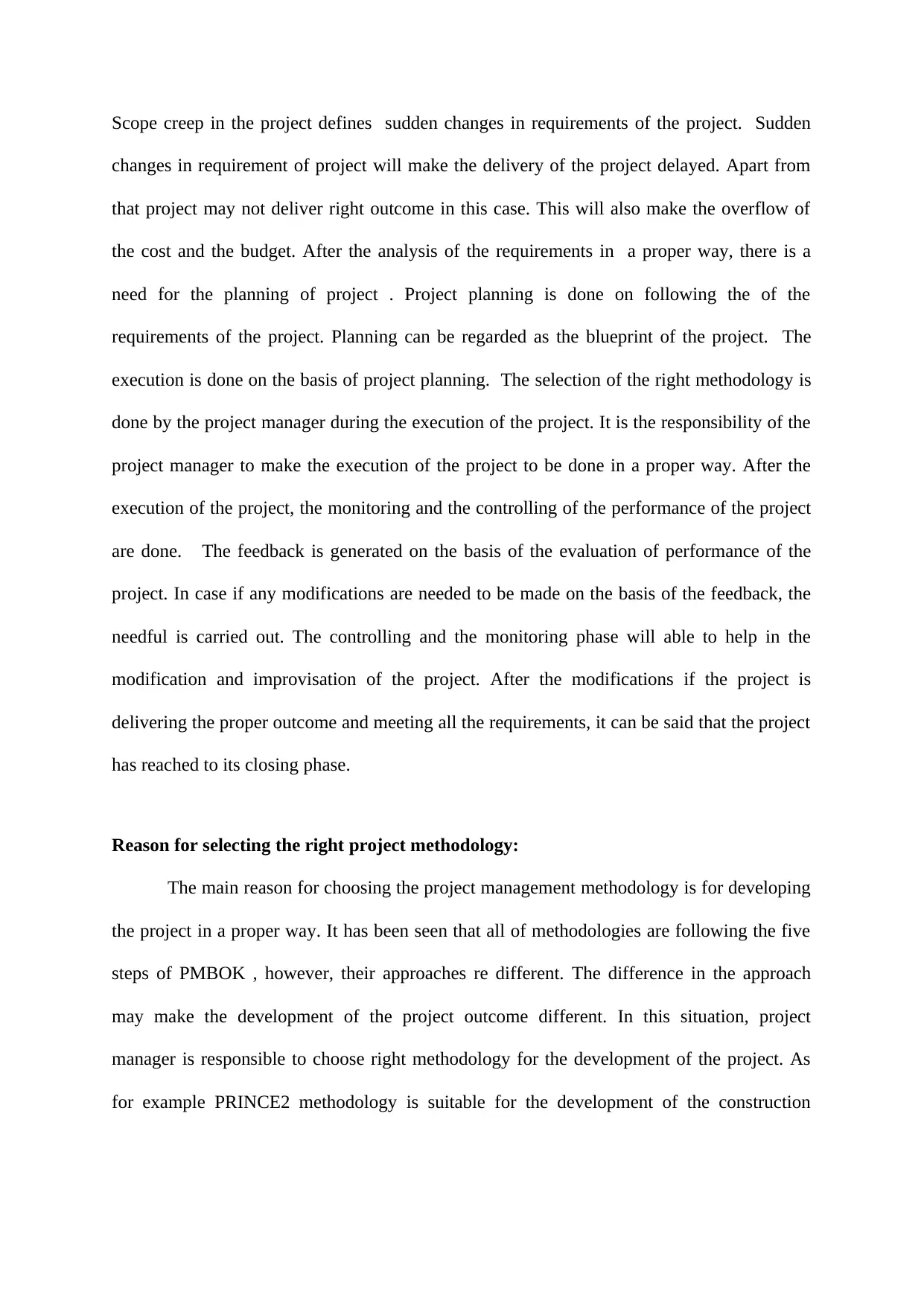
Scope creep in the project defines sudden changes in requirements of the project. Sudden
changes in requirement of project will make the delivery of the project delayed. Apart from
that project may not deliver right outcome in this case. This will also make the overflow of
the cost and the budget. After the analysis of the requirements in a proper way, there is a
need for the planning of project . Project planning is done on following the of the
requirements of the project. Planning can be regarded as the blueprint of the project. The
execution is done on the basis of project planning. The selection of the right methodology is
done by the project manager during the execution of the project. It is the responsibility of the
project manager to make the execution of the project to be done in a proper way. After the
execution of the project, the monitoring and the controlling of the performance of the project
are done. The feedback is generated on the basis of the evaluation of performance of the
project. In case if any modifications are needed to be made on the basis of the feedback, the
needful is carried out. The controlling and the monitoring phase will able to help in the
modification and improvisation of the project. After the modifications if the project is
delivering the proper outcome and meeting all the requirements, it can be said that the project
has reached to its closing phase.
Reason for selecting the right project methodology:
The main reason for choosing the project management methodology is for developing
the project in a proper way. It has been seen that all of methodologies are following the five
steps of PMBOK , however, their approaches re different. The difference in the approach
may make the development of the project outcome different. In this situation, project
manager is responsible to choose right methodology for the development of the project. As
for example PRINCE2 methodology is suitable for the development of the construction
changes in requirement of project will make the delivery of the project delayed. Apart from
that project may not deliver right outcome in this case. This will also make the overflow of
the cost and the budget. After the analysis of the requirements in a proper way, there is a
need for the planning of project . Project planning is done on following the of the
requirements of the project. Planning can be regarded as the blueprint of the project. The
execution is done on the basis of project planning. The selection of the right methodology is
done by the project manager during the execution of the project. It is the responsibility of the
project manager to make the execution of the project to be done in a proper way. After the
execution of the project, the monitoring and the controlling of the performance of the project
are done. The feedback is generated on the basis of the evaluation of performance of the
project. In case if any modifications are needed to be made on the basis of the feedback, the
needful is carried out. The controlling and the monitoring phase will able to help in the
modification and improvisation of the project. After the modifications if the project is
delivering the proper outcome and meeting all the requirements, it can be said that the project
has reached to its closing phase.
Reason for selecting the right project methodology:
The main reason for choosing the project management methodology is for developing
the project in a proper way. It has been seen that all of methodologies are following the five
steps of PMBOK , however, their approaches re different. The difference in the approach
may make the development of the project outcome different. In this situation, project
manager is responsible to choose right methodology for the development of the project. As
for example PRINCE2 methodology is suitable for the development of the construction
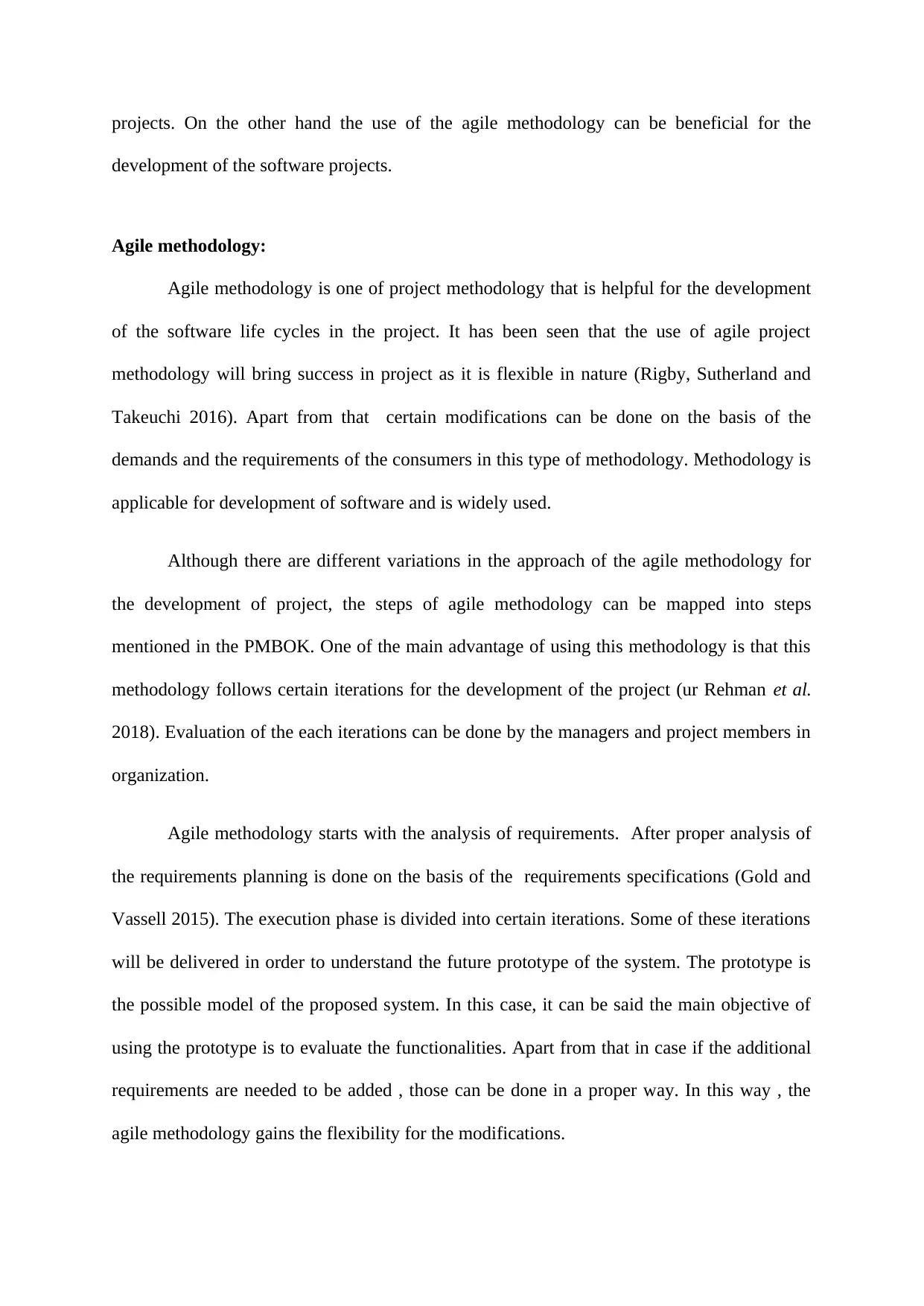
projects. On the other hand the use of the agile methodology can be beneficial for the
development of the software projects.
Agile methodology:
Agile methodology is one of project methodology that is helpful for the development
of the software life cycles in the project. It has been seen that the use of agile project
methodology will bring success in project as it is flexible in nature (Rigby, Sutherland and
Takeuchi 2016). Apart from that certain modifications can be done on the basis of the
demands and the requirements of the consumers in this type of methodology. Methodology is
applicable for development of software and is widely used.
Although there are different variations in the approach of the agile methodology for
the development of project, the steps of agile methodology can be mapped into steps
mentioned in the PMBOK. One of the main advantage of using this methodology is that this
methodology follows certain iterations for the development of the project (ur Rehman et al.
2018). Evaluation of the each iterations can be done by the managers and project members in
organization.
Agile methodology starts with the analysis of requirements. After proper analysis of
the requirements planning is done on the basis of the requirements specifications (Gold and
Vassell 2015). The execution phase is divided into certain iterations. Some of these iterations
will be delivered in order to understand the future prototype of the system. The prototype is
the possible model of the proposed system. In this case, it can be said the main objective of
using the prototype is to evaluate the functionalities. Apart from that in case if the additional
requirements are needed to be added , those can be done in a proper way. In this way , the
agile methodology gains the flexibility for the modifications.
development of the software projects.
Agile methodology:
Agile methodology is one of project methodology that is helpful for the development
of the software life cycles in the project. It has been seen that the use of agile project
methodology will bring success in project as it is flexible in nature (Rigby, Sutherland and
Takeuchi 2016). Apart from that certain modifications can be done on the basis of the
demands and the requirements of the consumers in this type of methodology. Methodology is
applicable for development of software and is widely used.
Although there are different variations in the approach of the agile methodology for
the development of project, the steps of agile methodology can be mapped into steps
mentioned in the PMBOK. One of the main advantage of using this methodology is that this
methodology follows certain iterations for the development of the project (ur Rehman et al.
2018). Evaluation of the each iterations can be done by the managers and project members in
organization.
Agile methodology starts with the analysis of requirements. After proper analysis of
the requirements planning is done on the basis of the requirements specifications (Gold and
Vassell 2015). The execution phase is divided into certain iterations. Some of these iterations
will be delivered in order to understand the future prototype of the system. The prototype is
the possible model of the proposed system. In this case, it can be said the main objective of
using the prototype is to evaluate the functionalities. Apart from that in case if the additional
requirements are needed to be added , those can be done in a proper way. In this way , the
agile methodology gains the flexibility for the modifications.
⊘ This is a preview!⊘
Do you want full access?
Subscribe today to unlock all pages.

Trusted by 1+ million students worldwide
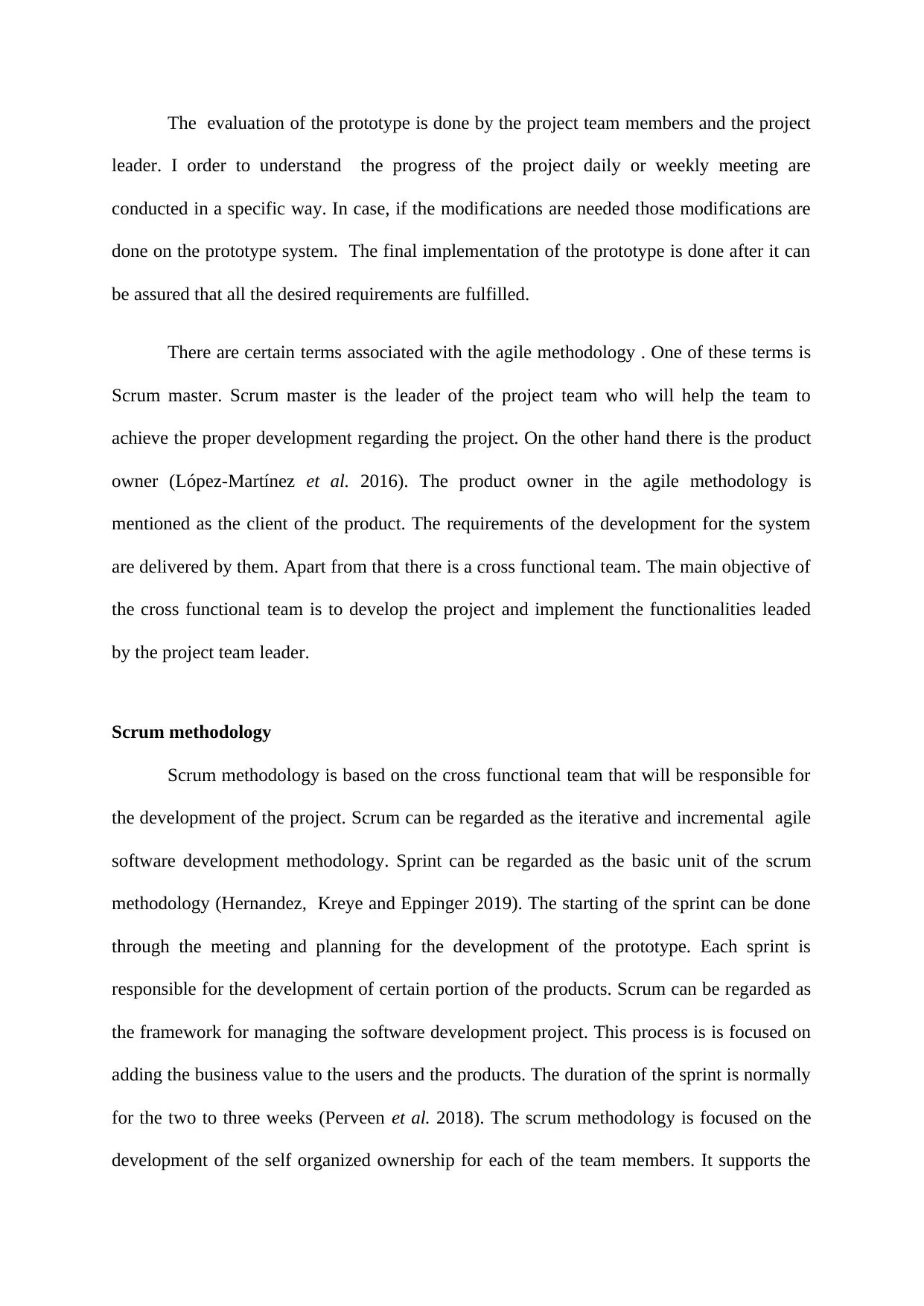
The evaluation of the prototype is done by the project team members and the project
leader. I order to understand the progress of the project daily or weekly meeting are
conducted in a specific way. In case, if the modifications are needed those modifications are
done on the prototype system. The final implementation of the prototype is done after it can
be assured that all the desired requirements are fulfilled.
There are certain terms associated with the agile methodology . One of these terms is
Scrum master. Scrum master is the leader of the project team who will help the team to
achieve the proper development regarding the project. On the other hand there is the product
owner (López-Martínez et al. 2016). The product owner in the agile methodology is
mentioned as the client of the product. The requirements of the development for the system
are delivered by them. Apart from that there is a cross functional team. The main objective of
the cross functional team is to develop the project and implement the functionalities leaded
by the project team leader.
Scrum methodology
Scrum methodology is based on the cross functional team that will be responsible for
the development of the project. Scrum can be regarded as the iterative and incremental agile
software development methodology. Sprint can be regarded as the basic unit of the scrum
methodology (Hernandez, Kreye and Eppinger 2019). The starting of the sprint can be done
through the meeting and planning for the development of the prototype. Each sprint is
responsible for the development of certain portion of the products. Scrum can be regarded as
the framework for managing the software development project. This process is is focused on
adding the business value to the users and the products. The duration of the sprint is normally
for the two to three weeks (Perveen et al. 2018). The scrum methodology is focused on the
development of the self organized ownership for each of the team members. It supports the
leader. I order to understand the progress of the project daily or weekly meeting are
conducted in a specific way. In case, if the modifications are needed those modifications are
done on the prototype system. The final implementation of the prototype is done after it can
be assured that all the desired requirements are fulfilled.
There are certain terms associated with the agile methodology . One of these terms is
Scrum master. Scrum master is the leader of the project team who will help the team to
achieve the proper development regarding the project. On the other hand there is the product
owner (López-Martínez et al. 2016). The product owner in the agile methodology is
mentioned as the client of the product. The requirements of the development for the system
are delivered by them. Apart from that there is a cross functional team. The main objective of
the cross functional team is to develop the project and implement the functionalities leaded
by the project team leader.
Scrum methodology
Scrum methodology is based on the cross functional team that will be responsible for
the development of the project. Scrum can be regarded as the iterative and incremental agile
software development methodology. Sprint can be regarded as the basic unit of the scrum
methodology (Hernandez, Kreye and Eppinger 2019). The starting of the sprint can be done
through the meeting and planning for the development of the prototype. Each sprint is
responsible for the development of certain portion of the products. Scrum can be regarded as
the framework for managing the software development project. This process is is focused on
adding the business value to the users and the products. The duration of the sprint is normally
for the two to three weeks (Perveen et al. 2018). The scrum methodology is focused on the
development of the self organized ownership for each of the team members. It supports the
Paraphrase This Document
Need a fresh take? Get an instant paraphrase of this document with our AI Paraphraser
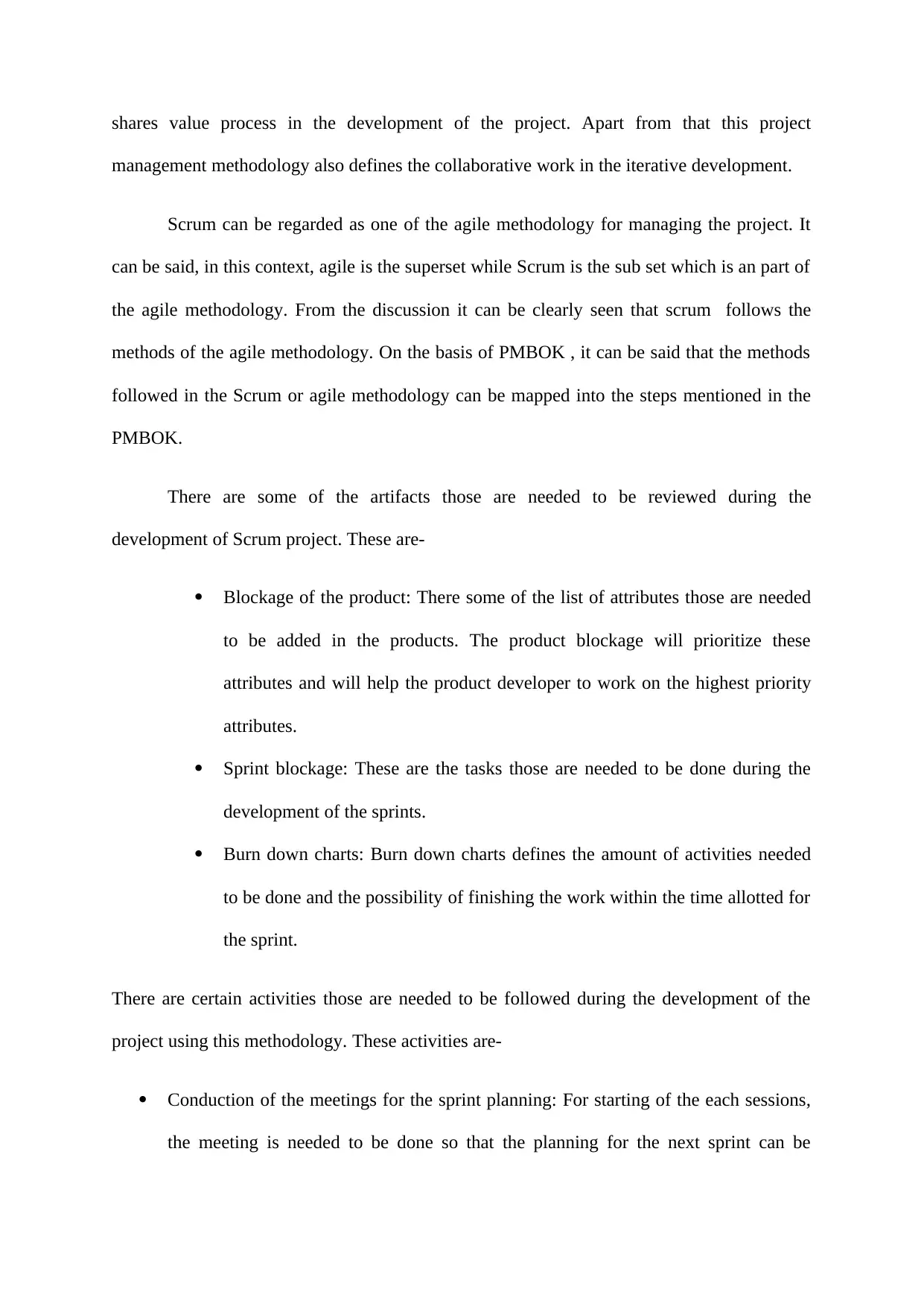
shares value process in the development of the project. Apart from that this project
management methodology also defines the collaborative work in the iterative development.
Scrum can be regarded as one of the agile methodology for managing the project. It
can be said, in this context, agile is the superset while Scrum is the sub set which is an part of
the agile methodology. From the discussion it can be clearly seen that scrum follows the
methods of the agile methodology. On the basis of PMBOK , it can be said that the methods
followed in the Scrum or agile methodology can be mapped into the steps mentioned in the
PMBOK.
There are some of the artifacts those are needed to be reviewed during the
development of Scrum project. These are-
Blockage of the product: There some of the list of attributes those are needed
to be added in the products. The product blockage will prioritize these
attributes and will help the product developer to work on the highest priority
attributes.
Sprint blockage: These are the tasks those are needed to be done during the
development of the sprints.
Burn down charts: Burn down charts defines the amount of activities needed
to be done and the possibility of finishing the work within the time allotted for
the sprint.
There are certain activities those are needed to be followed during the development of the
project using this methodology. These activities are-
Conduction of the meetings for the sprint planning: For starting of the each sessions,
the meeting is needed to be done so that the planning for the next sprint can be
management methodology also defines the collaborative work in the iterative development.
Scrum can be regarded as one of the agile methodology for managing the project. It
can be said, in this context, agile is the superset while Scrum is the sub set which is an part of
the agile methodology. From the discussion it can be clearly seen that scrum follows the
methods of the agile methodology. On the basis of PMBOK , it can be said that the methods
followed in the Scrum or agile methodology can be mapped into the steps mentioned in the
PMBOK.
There are some of the artifacts those are needed to be reviewed during the
development of Scrum project. These are-
Blockage of the product: There some of the list of attributes those are needed
to be added in the products. The product blockage will prioritize these
attributes and will help the product developer to work on the highest priority
attributes.
Sprint blockage: These are the tasks those are needed to be done during the
development of the sprints.
Burn down charts: Burn down charts defines the amount of activities needed
to be done and the possibility of finishing the work within the time allotted for
the sprint.
There are certain activities those are needed to be followed during the development of the
project using this methodology. These activities are-
Conduction of the meetings for the sprint planning: For starting of the each sessions,
the meeting is needed to be done so that the planning for the next sprint can be
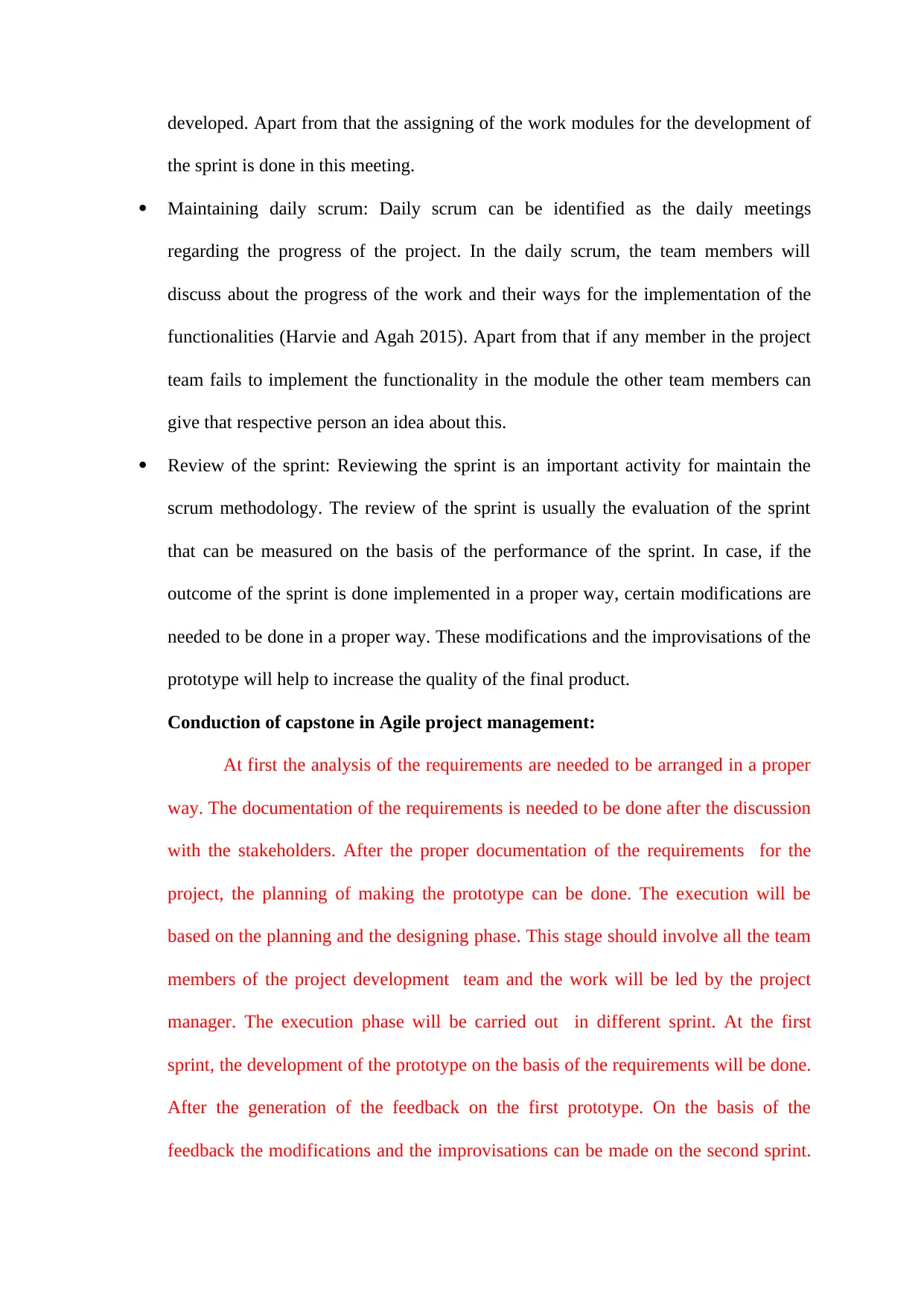
developed. Apart from that the assigning of the work modules for the development of
the sprint is done in this meeting.
Maintaining daily scrum: Daily scrum can be identified as the daily meetings
regarding the progress of the project. In the daily scrum, the team members will
discuss about the progress of the work and their ways for the implementation of the
functionalities (Harvie and Agah 2015). Apart from that if any member in the project
team fails to implement the functionality in the module the other team members can
give that respective person an idea about this.
Review of the sprint: Reviewing the sprint is an important activity for maintain the
scrum methodology. The review of the sprint is usually the evaluation of the sprint
that can be measured on the basis of the performance of the sprint. In case, if the
outcome of the sprint is done implemented in a proper way, certain modifications are
needed to be done in a proper way. These modifications and the improvisations of the
prototype will help to increase the quality of the final product.
Conduction of capstone in Agile project management:
At first the analysis of the requirements are needed to be arranged in a proper
way. The documentation of the requirements is needed to be done after the discussion
with the stakeholders. After the proper documentation of the requirements for the
project, the planning of making the prototype can be done. The execution will be
based on the planning and the designing phase. This stage should involve all the team
members of the project development team and the work will be led by the project
manager. The execution phase will be carried out in different sprint. At the first
sprint, the development of the prototype on the basis of the requirements will be done.
After the generation of the feedback on the first prototype. On the basis of the
feedback the modifications and the improvisations can be made on the second sprint.
the sprint is done in this meeting.
Maintaining daily scrum: Daily scrum can be identified as the daily meetings
regarding the progress of the project. In the daily scrum, the team members will
discuss about the progress of the work and their ways for the implementation of the
functionalities (Harvie and Agah 2015). Apart from that if any member in the project
team fails to implement the functionality in the module the other team members can
give that respective person an idea about this.
Review of the sprint: Reviewing the sprint is an important activity for maintain the
scrum methodology. The review of the sprint is usually the evaluation of the sprint
that can be measured on the basis of the performance of the sprint. In case, if the
outcome of the sprint is done implemented in a proper way, certain modifications are
needed to be done in a proper way. These modifications and the improvisations of the
prototype will help to increase the quality of the final product.
Conduction of capstone in Agile project management:
At first the analysis of the requirements are needed to be arranged in a proper
way. The documentation of the requirements is needed to be done after the discussion
with the stakeholders. After the proper documentation of the requirements for the
project, the planning of making the prototype can be done. The execution will be
based on the planning and the designing phase. This stage should involve all the team
members of the project development team and the work will be led by the project
manager. The execution phase will be carried out in different sprint. At the first
sprint, the development of the prototype on the basis of the requirements will be done.
After the generation of the feedback on the first prototype. On the basis of the
feedback the modifications and the improvisations can be made on the second sprint.
⊘ This is a preview!⊘
Do you want full access?
Subscribe today to unlock all pages.

Trusted by 1+ million students worldwide
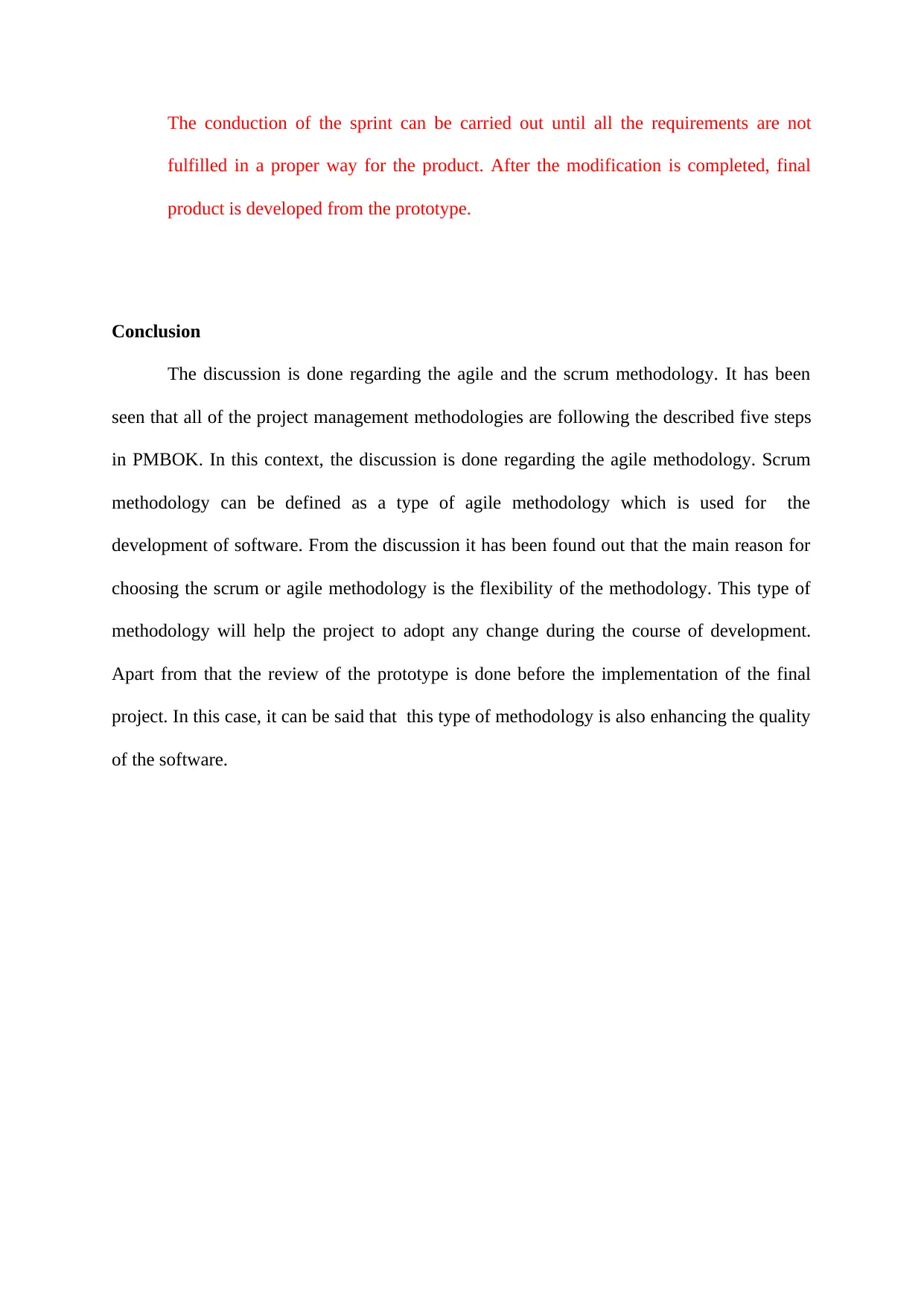
The conduction of the sprint can be carried out until all the requirements are not
fulfilled in a proper way for the product. After the modification is completed, final
product is developed from the prototype.
Conclusion
The discussion is done regarding the agile and the scrum methodology. It has been
seen that all of the project management methodologies are following the described five steps
in PMBOK. In this context, the discussion is done regarding the agile methodology. Scrum
methodology can be defined as a type of agile methodology which is used for the
development of software. From the discussion it has been found out that the main reason for
choosing the scrum or agile methodology is the flexibility of the methodology. This type of
methodology will help the project to adopt any change during the course of development.
Apart from that the review of the prototype is done before the implementation of the final
project. In this case, it can be said that this type of methodology is also enhancing the quality
of the software.
fulfilled in a proper way for the product. After the modification is completed, final
product is developed from the prototype.
Conclusion
The discussion is done regarding the agile and the scrum methodology. It has been
seen that all of the project management methodologies are following the described five steps
in PMBOK. In this context, the discussion is done regarding the agile methodology. Scrum
methodology can be defined as a type of agile methodology which is used for the
development of software. From the discussion it has been found out that the main reason for
choosing the scrum or agile methodology is the flexibility of the methodology. This type of
methodology will help the project to adopt any change during the course of development.
Apart from that the review of the prototype is done before the implementation of the final
project. In this case, it can be said that this type of methodology is also enhancing the quality
of the software.
Paraphrase This Document
Need a fresh take? Get an instant paraphrase of this document with our AI Paraphraser
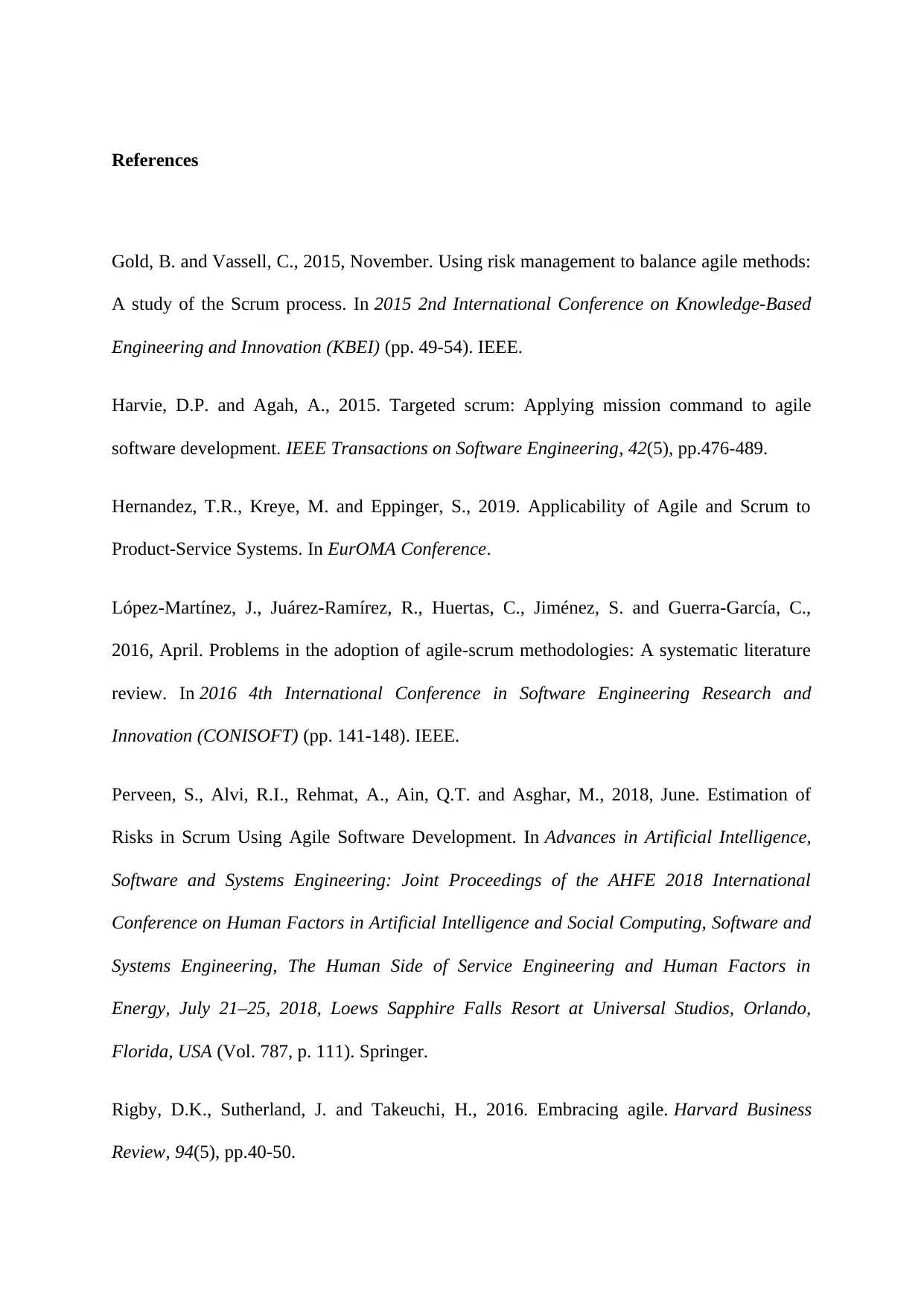
References
Gold, B. and Vassell, C., 2015, November. Using risk management to balance agile methods:
A study of the Scrum process. In 2015 2nd International Conference on Knowledge-Based
Engineering and Innovation (KBEI) (pp. 49-54). IEEE.
Harvie, D.P. and Agah, A., 2015. Targeted scrum: Applying mission command to agile
software development. IEEE Transactions on Software Engineering, 42(5), pp.476-489.
Hernandez, T.R., Kreye, M. and Eppinger, S., 2019. Applicability of Agile and Scrum to
Product-Service Systems. In EurOMA Conference.
López-Martínez, J., Juárez-Ramírez, R., Huertas, C., Jiménez, S. and Guerra-García, C.,
2016, April. Problems in the adoption of agile-scrum methodologies: A systematic literature
review. In 2016 4th International Conference in Software Engineering Research and
Innovation (CONISOFT) (pp. 141-148). IEEE.
Perveen, S., Alvi, R.I., Rehmat, A., Ain, Q.T. and Asghar, M., 2018, June. Estimation of
Risks in Scrum Using Agile Software Development. In Advances in Artificial Intelligence,
Software and Systems Engineering: Joint Proceedings of the AHFE 2018 International
Conference on Human Factors in Artificial Intelligence and Social Computing, Software and
Systems Engineering, The Human Side of Service Engineering and Human Factors in
Energy, July 21–25, 2018, Loews Sapphire Falls Resort at Universal Studios, Orlando,
Florida, USA (Vol. 787, p. 111). Springer.
Rigby, D.K., Sutherland, J. and Takeuchi, H., 2016. Embracing agile. Harvard Business
Review, 94(5), pp.40-50.
Gold, B. and Vassell, C., 2015, November. Using risk management to balance agile methods:
A study of the Scrum process. In 2015 2nd International Conference on Knowledge-Based
Engineering and Innovation (KBEI) (pp. 49-54). IEEE.
Harvie, D.P. and Agah, A., 2015. Targeted scrum: Applying mission command to agile
software development. IEEE Transactions on Software Engineering, 42(5), pp.476-489.
Hernandez, T.R., Kreye, M. and Eppinger, S., 2019. Applicability of Agile and Scrum to
Product-Service Systems. In EurOMA Conference.
López-Martínez, J., Juárez-Ramírez, R., Huertas, C., Jiménez, S. and Guerra-García, C.,
2016, April. Problems in the adoption of agile-scrum methodologies: A systematic literature
review. In 2016 4th International Conference in Software Engineering Research and
Innovation (CONISOFT) (pp. 141-148). IEEE.
Perveen, S., Alvi, R.I., Rehmat, A., Ain, Q.T. and Asghar, M., 2018, June. Estimation of
Risks in Scrum Using Agile Software Development. In Advances in Artificial Intelligence,
Software and Systems Engineering: Joint Proceedings of the AHFE 2018 International
Conference on Human Factors in Artificial Intelligence and Social Computing, Software and
Systems Engineering, The Human Side of Service Engineering and Human Factors in
Energy, July 21–25, 2018, Loews Sapphire Falls Resort at Universal Studios, Orlando,
Florida, USA (Vol. 787, p. 111). Springer.
Rigby, D.K., Sutherland, J. and Takeuchi, H., 2016. Embracing agile. Harvard Business
Review, 94(5), pp.40-50.

ur Rehman, F., Maqbool, B., Riaz, M.Q., Qamar, U. and Abbas, M., 2018, April. Scrum
Software Maintenance Model: Efficient Software Maintenance in Agile Methodology.
In 2018 21st Saudi Computer Society National Computer Conference (NCC) (pp. 1-5). IEEE.
Software Maintenance Model: Efficient Software Maintenance in Agile Methodology.
In 2018 21st Saudi Computer Society National Computer Conference (NCC) (pp. 1-5). IEEE.
⊘ This is a preview!⊘
Do you want full access?
Subscribe today to unlock all pages.

Trusted by 1+ million students worldwide
1 out of 9
Related Documents
Your All-in-One AI-Powered Toolkit for Academic Success.
+13062052269
info@desklib.com
Available 24*7 on WhatsApp / Email
![[object Object]](/_next/static/media/star-bottom.7253800d.svg)
Unlock your academic potential
Copyright © 2020–2025 A2Z Services. All Rights Reserved. Developed and managed by ZUCOL.




